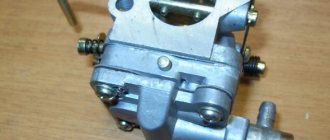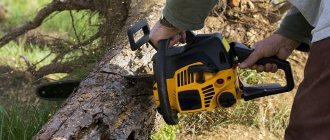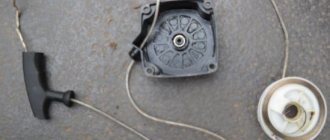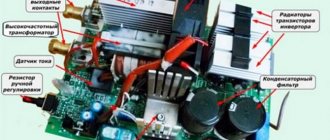Although chainsaws have different names, they are structurally similar. The starting mechanisms of gasoline units, with the help of which the engine starts, are also similar. Mechanisms for starting internal combustion engines are suitable for chainsaws of various brands Shtil, Husqvarna, Dolmar, Makita and others. Structurally, a starter for a chainsaw consists of the following elements:
- The drum on which the cable is wound
- A cable that moves the crankshaft of the tool
- Handle for ease of use of the mechanism
- A frame with a spring, thanks to which the cable is wound onto the drum (returned to its original position) when the sawyer starts the motor
The operating principle of such a device is simple. When the handle of the mechanism is sharply lifted, the cable is pulled out. The cable engages with the ratchet, transmitting movement to the splined drum. This is how the crankshaft moves through several revolutions. At this moment, the working mixture is compressed in the cylinder. As soon as the handle returns to its original position, the connection between the ratchet and the splines is released and the shaft stops rotating.
With each subsequent pull of the cable, the amount of fuel-air mixture in the cylinder increases. To ensure that the cable returns to its original position, return springs are used in the design of the trigger mechanism. They are made of elastic steel. It is this spring that often causes a unit starter to malfunction, which can be repaired.
Typical faults
The most common tool failures include the following:
- problems in the ignition system;
- stopping the chainsaw while cutting;
- loss of power during operation;
- wear of some structural elements of the chainsaw (brake band, drive sprockets, anti-vibration parts);
- problems in the fuel supply system;
- starter related problems.
In addition, it is necessary to carry out a visual inspection of the chainsaw before starting work and take preventive measures. These include lubrication of the chain, control of the amount of fuel mixture, as well as the presence of the required amount of oil.
The spark plug is unscrewed to check its condition.
Each of the faults is eliminated using its own technology. For example, repairing the fuel system of a chainsaw should begin with inspecting the corresponding filter. After this, check the correct adjustment of the carburetor, which is carried out using screws. The gaps must be set in strict accordance with the manufacturer's instructions, which must be included with the chainsaw.
Checking the spark plugs
The first step is to check the spark plugs. You need to disconnect the wire that goes to the latter and unscrew it with a special key. Based on the condition of the spark plug, you can determine possible problems:
- a dry spark plug indicates that there is no access of the incendiary mixture to the cylinder; the ignition system has nothing to do with it. The cause of the breakdown may be a clogged conductive tube or a problem with the carburetor. It is necessary to clean the fuel line and check the functionality of the fuel pump and carburetor. If one of the mechanisms does not work, it is necessary to replace it with a new one, since repairing the latter is impossible in the absence of professional skills;
- A wet spark plug indicates an excess of fuel mixture in the cylinder or water getting into it. It is necessary to dry the spark plug, remove any remaining liquid and blow out the cylinder chamber - with the fuel supply turned off, start the starter. Then you should put the spark plug on and start it again. When checking, you need to measure the gap between the electrodes; an indicator from 0.5 to 0.65 mm is considered acceptable. In case of damage or signs of abrasion, the gasket must be replaced. If after the above operations the spark is good, there may be a problem with the quality of gasoline. Absence or unevenness is an ignition problem. There is a possibility of damage to the supply wire or spark plug. If the new spark plug does not respond, it is necessary to inspect the starting system in more detail;
- a spark plug with a black coating of soot is evidence of the possible use of low-quality lubricant, an imbalance in the “gasoline-oil” balance in favor of the latter, or a clogged one of the filters. Clogging leads to a loss of power of the chainsaw and its subsequent stoppage. The dust does not burn completely and settles on the cylinder walls as a layer of black soot. You need to change the fuel, clean the fuel filter, wash and dry the air filter. Remove soot from the candle using an awl or needle, and clean the contacts with medium-sized sandpaper.
Chainsaw starter repair
When the chainsaw is started frequently, some parts of the starter are constantly subjected to dynamic loads. As a result, the cable may burst, several teeth of the ratchet may crumble, and the shaft will rotate at a much lower speed. Therefore, inspection and even repair of the starter are operations that are sometimes carried out several times a season.
Replacing the cord
When it is pulled out, there is constant friction of the cable against the starter housing. To replace, disassemble the unit body and carefully lift the ratchet drum so as to prevent the return spring from jumping off its sockets. It is better to do this work together: an assistant fixes the spring while the cable is being replaced. After securing the cable in the handle and in the grooves of the drum, the cable is wound onto the roller, and the body is assembled.
Spring repair
If the material of the starter spring turns out to be of poor quality, the spring will burst (usually at the point where it attaches to the drum, where it forms a loop). In this case, there is no need to replace the spring. It is enough to thoroughly clean its surface from dirt and traces of lubricant, carefully sand the damaged area, and then release the spring at 600...650°C (the steel of the spring should acquire a crimson color). It is necessary to cool the spring slowly, and at 100…150ºС you can carefully wrap its end in the shape of the limiting protrusion on the inner surface of the drum (the steel will acquire the necessary plasticity) and insert it into place. The elastic properties of the spring will not change.
Review of the range of petrol chain saws Caliber
Chainsaw Caliber BP-1500/16U
This model is ideal for small jobs. It is very convenient to use because it has a minimal level of vibration and fuel consumption.
Chainsaw Caliber BP-1800/16U
This model is perfect for those who plan to frequently cut firewood and prepare it for the winter. Its engine has a power of 2.45 hp. and a 16-inch tire can ensure long-term continuous operation.
Chainsaw Caliber BP-2200/18u
This model is ideal for regular private work. It can easily cope with sawing logs, collecting firewood and performing minor construction work.
Chainsaw Caliber BP-2300/18
This model appeared relatively recently. It has an increased service life, an improved engine cooling system, a brake lever on both sides (left and right), a primer for pumping fuel, and a comfortable rubberized handle.
Chainsaw Caliber Profi BP-2600/18u
It has an engine with a power of 3.5 hp. Caliber BP-2600/18u is a semi-professional model and can be successfully used in small logging companies.
Chainsaw Caliber Profi BP-2800/18u
This is the most powerful model of the Caliber chainsaw. Its motor has a power of 2800 W. At the same time, the installed primer can significantly facilitate the start-up process in any weather conditions. A carefully balanced body and a vibration damping system make operating the Caliber BP-2800/18u chainsaw as simple and comfortable as possible, even under high loads.
Chainsaw starter device
Almost all leading manufacturers of chainsaws equip their products with starters of a similar operating principle. It is no coincidence that specialized stores offer universal starter designs that are equally suitable for Shtil, Husqvarna, Makita chainsaws, and for Chinese semi-official counterfeits of the named brands. Only domestically produced chainsaw starters (Lesnik, Ural and a number of others) have some features.
The principle of operation of a starter for a chainsaw is as follows. A handle is installed in a groove in the housing, through which a cable is passed. If the handle is sharply raised, the cable is pulled out and engages the drum of the ratcheting mechanism, which transmits the movement to the drum with splines provided on the shaft. In this case, the crankshaft makes several revolutions, and the working mixture in the space between the piston and the cylinder head is compressed. Accordingly, when the handle is lowered, contact between the ratchet and the splines is lost and the shaft stops.
As engine volume increases, the required amount of fuel-air mixture required for its subsequent ignition also increases, so the number of pulls on the starting cable for high-power saws increases. Therefore, in order to speed up the return of the drum, involuntary return springs made of steel with high elastic properties are used.
Making it easier to start a chainsaw is done in the following ways:
- Preliminary enrichment of the working mixture, for which there is a special damper in the carburetor design.
- Installation of an automatic decompression valve, which reduces the operating pressure in the chainsaw cylinder.
- By installing an additional spring, which during the process of moving the cable facilitates the unwinding of the crankshaft.
- The presence in the design of some chainsaws (for example, Partner S series, Maxcut, etc.) of a primer - a pump that provides preliminary fuel pumping.
Method for starting a hot engine and an engine equipped with a decompression system.
A hot engine does not need to enrich the fuel mixture with air, so you can start the saw without closing the air damper. Simply turn on the ignition and move the starter, after which a working chainsaw should start.
Large-volume engines have fairly severe compression, which makes cranking extremely difficult. To reduce the effort required to start a saw of large volume and power, manufacturers use special decompression valves, when pressed, the compression is noticeably reduced and the engine turns over more easily.
Valves may have different appearances, so read the instructions for the tool in advance.
Thus, before any kind of starting, be it hot or cold, it is necessary to press this valve, designed to reduce resistance, and thereby increase the service life of the starting device.
In conclusion of the article, we can summarize the key points of starting a chainsaw. First, you need to start it with maximum safety. Second, any deviations from the launch algorithm are not allowed. And finally, you can’t start a chainsaw without a starter! Take the information from the article into account and use your tool correctly.
What to do if the chainsaw starter cord breaks?
The cord may break where it is attached to the trigger reel or handle. A break in the middle is extremely unlikely, since manufacturers use very strong and wear-resistant nylon cables to make products. Such material can be sold in whole coils, but given the short length, it is wise to purchase a starter cord at a sports or hardware store.
To replace it, it is enough to buy 1-2 linear meters of thin nylon cable and make simple repairs with your own hands in a short time. This will save not only money, but also a lot of time compared to going to a repair shop. If you have all the necessary spare parts on hand, then in 20 minutes you will have a working chainsaw.
The design and principle of operation of a chainsaw starter
All types of chainsaws, both Chinese and European, are equipped with starters of identical design and operating principle. The universal design of starters allows these devices to be used both on branded chainsaws and on semi-official tools supplied from the Middle Kingdom. It is only important to note that domestically produced instruments have some distinctive features.
A starter for a chainsaw is a simple mechanism consisting of:
- Drum.
- Rope.
- A handle connected to a cable.
- Frame with return spring.
The operating principle of such a device is also quite simple. When the handle, which is connected by a cable to the drum of the ratcheting mechanism, is pulled, it moves. When moving, the drum engages with the splines of another drum, which is located on the shaft. Thus, the crankshaft of the saw moves manually, which makes several revolutions. As soon as the handle returns to its original position, assisted by the return spring, the spline connection is lost, causing the shaft to stop. With each movement of the crankshaft, the amount of fuel-air mixture in the cylinder increases, which ultimately contributes to its ignition.
The greater the power of the tool, the more jerks the starter must make to start the engine. The return spring, which is manufactured using steel with a high degree of elasticity, is responsible for accelerating the return of the drum to its original position.
Over time, with constant use of the tool, problems are observed with starting the engine, or more precisely, with the functioning of the starter. If such problems arise, the starter can always be repaired. If you know the principle and design of the starter, then repairing it yourself will not be difficult at all.
Typical breakdowns and repairs of a chainsaw starter
Before carrying out repairs, it is necessary to find out the causes of the breakdown. Since the product is constantly exposed to dynamic and other types of loads, its failure cannot be ruled out. Frequent causes of starter breakdowns are: cable rupture, abrasion or chipping of several splines of the ratchet drum, spring damage, pulley crack, and others. To determine why the saw does not start, you will need to carry out an appropriate inspection of the starter mechanism. Let's look at the main types of faults, and also find out how to properly repair the product.
Replacing the cord
The starter cord is a strong rope that is quite resistant to wear, but even its technical properties do not save it from damage. Each time the tool is started, the rope rubs against the body of the starter cover, which leads to its gradual chafing and wear.
If the cord is frayed, then to replace it you will need to disassemble the housing of this unit. After removing the cover, it is necessary to lift the drum, but only in such a way that it does not jump out of its seats. It is recommended to carry out this work together with a partner who will fix the spring, and you will replace the cable. The remains of the old cable should be removed, and then the new product should be secured in the handle and in the groove of the drum. After this, the cable should be wound onto the roller, and finally assemble the housing.
It is important to know! Before fixing the cable in the handle, you should pass it through the corresponding hole in the starter cover.
How to replace a chainsaw starter spring
If the spring is damaged, which often happens on Chinese instruments, then the mechanism can only be repaired by replacing it. But if its damage occurred at the point of attachment, that is, the ear burst, then it can be repaired.
Repairing a spring involves heating the fracture site to 600 degrees, then slowly cooling it to 100 degrees, at which point the end is folded into the shape of the fragment. Thus, it will be possible to avoid loss of elasticity of the product, which will extend its service life. Although most specialists simply replace the product with a new one.
The most common injuries
Most often you can encounter the following malfunctions:
- Failure of the ignition system;
- Sudden stop of the saw;
- Power reduction;
- Wear and tear of chainsaw systems and mechanisms;
- Problems with the fuel supply system;
- Faulty starter.
To avoid malfunctions, it is necessary to check the condition of the saw every time before starting work. The fuel level, oil availability, and chain lubrication should be monitored. It is easier to prevent problems through timely preventive inspection than to fix them later.
The malfunction of each system is eliminated using different methods. Some breakdowns can be fixed with your own hands. For example, if there is a problem with the fuel supply system, you should first check the filter. Then you need to see if the carburetor is adjusted correctly. All gaps must be adjusted in full accordance with the instructions that come with the saw. You should also check the condition of the spark plugs. If there is visible damage, a large layer of carbon deposits, displacement and other changes, it is necessary to replace damaged and faulty elements.
Repair
If there is a problem with the starter, the chainsaw will not be able to start working after the cord is pulled. The tool will not start. The main reasons for saw failure may be:
- Pulley cracks or breakage;
- Spring damage;
- Trigger cable break.
To carry out inspection and repair, the following tools and parts are required:
- Necessary screwdrivers, or a handle with interchangeable attachments that are suitable for this work;
- Replacement elements to replace faulty ones if necessary (for example, a replacement cord).
To inspect and repair the starter, you first need to remove it from the housing. This can be done by using a screwdriver or other special tool to unscrew the screws that hold the side cover with the starter. Next you need to remove the cover and inspect the mechanism. The screw that attaches the mechanism to the cover of the chainsaw should be unscrewed, and then the clamp and the trigger spring should be removed. This will provide access to the pulley with the wound cord. If the cord is damaged, it must be replaced with a new one. If the failure involved a broken cord, these actions will bring the saw back into working order. All other elements of the mechanism should be carefully inspected for damage.
Sometimes upon examination you may notice other damage, namely:
- Pulley damage. This includes splits, tears and other damage that prevent the instrument from working properly;
- Chainsaw starting spring malfunction. This includes problems with the spring and defects in the mounting location. The place where the spring is inserted into the fastener is considered the most problematic part of the fastener.
Having completed the repair and replacement of parts with your own hands, you need to assemble the mechanism correctly, in the reverse order. The pulley must be installed on top of the trigger spring and be firmly engaged with it. The pulley is wrapped with a cord threaded through a hole in the cover so that when it starts and rotates, it pulls the cord into the mechanism. To obtain the required cord voltage, you should make 4 turns - this is enough. You can get acquainted with the starter repair technology by watching the video.
To fix problems yourself, you may need additional steps. For example, if you cannot match the openings for the cord in the pulley and the housing cover the first time, you should make several additional turns.
After the mechanism has been repaired and installed in place, the launch can begin. All repair work does not have to be carried out at home. If you don’t have enough experience and free time, you can contact the service center.
Timely preventative maintenance will help avoid sudden breakdowns. If you approach working with a chainsaw responsibly, monitor its technical condition, monitor the quality of fuel, you can extend the life of the tool.
The design and principle of operation of a chainsaw starter
All types of chainsaws, both Chinese and European, are equipped with starters of identical design and operating principle. The universal design of starters allows these devices to be used both on branded chainsaws and on semi-official tools supplied from the Middle Kingdom. It is only important to note that domestically produced instruments have some distinctive features.
A starter for a chainsaw is a simple mechanism consisting of:
- Drum.
- Rope.
- A handle connected to a cable.
- Frame with return spring.
The operating principle of such a device is also quite simple. When the handle, which is connected by a cable to the drum of the ratcheting mechanism, is pulled, it moves. When moving, the drum engages with the splines of another drum, which is located on the shaft. Thus, the crankshaft of the saw moves manually, which makes several revolutions. As soon as the handle returns to its original position, assisted by the return spring, the spline connection is lost, causing the shaft to stop. With each movement of the crankshaft, the amount of fuel-air mixture in the cylinder increases, which ultimately contributes to its ignition.
The greater the power of the tool, the more jerks the starter must make to start the engine. The return spring, which is manufactured using steel with a high degree of elasticity, is responsible for accelerating the return of the drum to its original position.
Over time, with constant use of the tool, problems are observed with starting the engine, or more precisely, with the functioning of the starter. If such problems arise, the starter can always be repaired. If you know the principle and design of the starter, then repairing it yourself will not be difficult at all.
Carburetor tuning: main points
Reassembly of the carburetor is carried out only after complete cleaning, drying and blowing with compressed air. However, do not forget that some gaskets and seals, even if there is no damage, must be replaced.
You can begin adjusting the carburetor if it is correctly troubleshooted, of high quality assembly and flawless re-installation on the engine.
Adjustment screwdriver
Principles of carburetor tuning:
- screws H and L adjust the ratio of air and fuel mixture, i.e. throttle position. Tightening the screws clockwise leads to a lean mixture and the engine switches to low speeds. When unscrewing (counterclockwise), the mixture becomes richer and the engine speed increases;
- screw T is responsible for adjusting the idle speed: turning it clockwise increases their number, counterclockwise - decreases it;
- The screws are adjusted in LHT order.
Chainsaw carburetor calibration
The general adjustment algorithm looks something like this:
- Initially, the highest idle speed is found by turning screw L and then returning ¼ turn counterclockwise. If the chain rotates at idle, turn screw T in the same direction until it stops completely.
- With the engine warm and running at full speed, turn screw H ¼ turn to the left, then let the engine run for 10 seconds and check the maximum speed using a tachometer. It must correspond to the number indicated in the instrument passport.
- After calibration with screws L and H, using screw T, the idle speed is adjusted. If everything is done correctly, the engine will operate evenly in all its positions.
Reminders for calibrating the carburetor on the chainsaw body
Upon completion of the adjustment, all that remains is to reinstall the chainsaw cover with the insulating gasket, after which you can begin the main work. If the settings are correct, the chainsaw engine will receive the optimal fuel mixture. This will ensure its normal efficiency, as well as overall comfort and safety of working with the tool.
How to increase the life of a chainsaw
You need to have a couple of tires and at least four chains in reserve.
To ensure a uniform wear process, the chain must be turned 180° after three hours of operation, and after the same period of time the chain must be replaced with another one. Timely cleaning of the tool ensures that various holes are not clogged, which can lead to difficulty or even interruption of the supply of the fuel mixture, which will affect the operating condition of the chainsaw.
If you are not confident in your abilities and are afraid of ruining the unit, then it is better to turn to professionals. Due to their experience, they will always be able to correctly diagnose the problem and efficiently correct problems in your chainsaw.
Related Posts
Starting and setting up a chainsaw
There are no teeth, which is perhaps easier than starting a chainsaw and working with it. Alas, as in any process, there are a huge number of pitfalls in this matter. Follow safety precautions, and starting a chainsaw won't be anything out of the ordinary. Accordingly, each type of saw comes with controls that need to be studied before performing work. The summary of what remains to be done for our client very carefully describes how to use the saw, how to prepare it for work and how to start it. You need to be very careful about the concept of running in a chainsaw. For two-stroke engine tools such as chainsaws, there is no concept of break-in.











